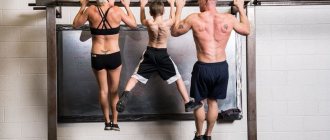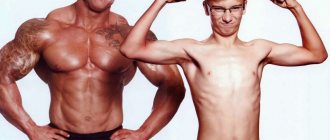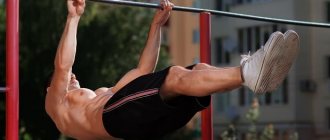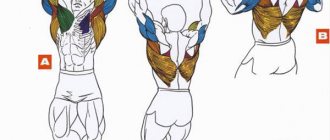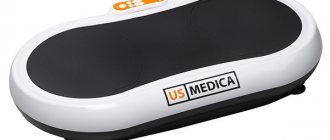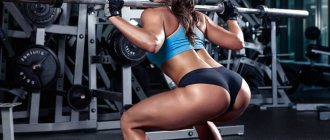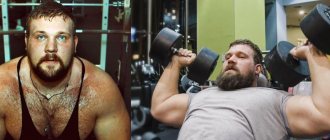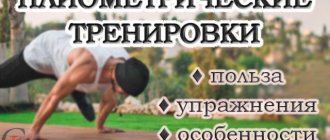One visit to your local gym and you feel like you're entering a matrix: lots of equipment and you're not sure you know how to use it. In this article we will look at what types of exercise equipment there are in the gym and how to exercise on them.
Below you will find reviews of the most popular sports equipment, their types, what they are intended for and how to use each of them for maximum results. All descriptions are accompanied by photos of the equipment itself, the muscle groups they work, and a video with the correct technique for performing the exercises.
We have compiled this equipment guide to provide detailed information about all types of fitness club equipment in one place and how to use them. This guide will help you create an effective exercise program.
Start of classes
Starting a workout at the gym is not easy. This is a whole world of weights and muscles, strong people.
Usually the program is prepared by the trainer of the fitness club you came to. The service is paid. We recommend that you take individual training for the first time (for a month) so that your trainer can teach you the correct exercise technique.
Training in the gym for beginners is an unsafe process, because the body is not yet accustomed to the stress. Therefore, at first it is better to practice under supervision.
It is important not to be shy to ask questions. You can ask for help from any coach working in this club or from the administrator if you are completely at a loss. Of course, only your trainer will advise you on the intricacies of your program, but another specialist can easily answer the question of how to use the exercise machine or where to drink water.
To correctly create a program, the coach must know:
- Human anatomy, features of muscle functioning, their location, dangerous moments.
- The basics of creating programs in various areas: for gaining muscle mass, for losing weight, for increasing strength, and so on.
- Know the technique of exercising most training elements, understand why this or that exercise is being done.
- Ideally, the coach has a specialized higher education.
What usually happens in the gyms: a person comes to work out after reading various tips on the Internet. Often with a ready-made program, which no one has adapted to his individual characteristics. It would be good if this person asks the trainer to show each exercise. Usually people try to get by exclusively with video tutorials. This is the wrong approach!
Remember that everything that is universal cannot be perfect. For the general reader, we can only give an approximate program that can be used as a basis. But the best results are achieved with individual work.
Important things to remember when using exercise machines
It is important to have a clear understanding of the equipment you have in your gym or when building it, as this will help you achieve your desired bodybuilding and fitness results.
Another important thing to mention is that proper form when using these machines cannot be overemphasized. When choosing between using more weight on the machine or maintaining proper positioning with less weight, always choose the second option based on your fitness level.
This will help you achieve better results, but more importantly, avoid injury.
Training outside the gym
The training program for beginners outside the gym is tailored to the individual’s individual characteristics, just like when working in the gym. Whether it's running or working on horizontal bars, an individual approach is important.
Everywhere you need to follow the principle of “do no harm” and “take your time.” This is the basis of safe training.
Where to start training outside the gym? Exactly the same with the warm-up. If you are a runner, you don't need any pre-cardio. Warming up before running involves elements of joint gymnastics. In all other cases, it is necessary to carefully prepare the body for work and raise the pulse.
When to increase weight: the “two for two” rule
Pete Bellis/Flickr.com
If you're looking to increase muscle mass, you'll likely be using low reps and heavy weights close to your one-time max.
It is important to understand here that in order to progress, the weight must be such that the last repetition in the set is on the verge of muscle failure. The “two for two” rule allows you to determine when you stop exercising to the point of muscle failure.
This rule was proposed by Thomas Baechle in the book Essentials of Strength Training and Conditioning. This is what it sounds like.
If you can do two more reps on the last set of any exercise, and you do it the last two workouts, it's time to increase the weight.
For example, let's say you do 4 sets of 8 reps of dumbbell curls. If you can do 10 reps on your last set two workouts in a row, it's time to increase the weight.
There is another, faster option for increasing working weight - a scheme of fixed approaches.
Coaches' mistakes
For beginners, a training program is important, and it is unacceptable for a beginner to create it himself if he does not have the proper experience and knowledge.
The correctness of the program will determine the result you will achieve. However, people working in fitness clubs are not always gurus in their field.
A chemist is not an adviser to a natural athlete
A beginner, unfamiliar with the world of iron, is guided by the size of the muscles and the relief of the trainer’s figure. That is, the healthier the coach, the more confidence he will inspire. The beginner does not know that impressive dimensions could be achieved thanks to the use of steroid drugs and pharmacology. That is, the coach has achieved good results, but, alas, he cannot always tell you how to achieve something without chemicals.
This is the main problem - an experienced jock is not always an experienced coach. He may recommend a program for chemists that is not suitable for natural athletes. In the case of chemists, the program will work great, but in the second case, a beginner will waste time and will not achieve the desired result. He wanted 50 cm biceps, but received an increase of only 1 cm to the existing result. Without knowing these subtleties, one might think that the beginner has bad genetics, or he did the exercises incorrectly. But that's not true.
Therefore, when turning to a person for a program, emphasize that you are interested in natural weight gain.
Irresponsible attitude towards the health of a newcomer
Many people suffer from back pain. They are advised to strengthen their backs and start going to the gym. This is the right recommendation because you need to train your back and abs. Then the load on the spine will be less, and the pinched nerves will go away. The muscle corset will create comfortable shock absorption when jumping and moving.
What do trainers do: a person complains of lumbar osteochondrosis or hernia. And they told him to do deadlifts. You can probably already guess how it will all end.
Of course, with careful attention from the instructor, everything will be fine, the person will be able to heal his back. But in some cases there is no such control; most beginners go to the gym on their own. Beginner and deadlift are an explosive mixture, the explosion of which leaves an injured lower back.
The same applies to squats. Incorrect technique, haste in choosing a weight - and now the newbie is already at an appointment with a neurologist.
Popular gym equipment, their purpose and working muscles
Power frame
Description: In the case of performing squat exercises. In fitness and strength training, this exercise trains your body completely. All serious training programs should include this machine.
Pro tip: Squat until your thighs are parallel to the floor. Squatting this low is essential for proper execution and ultimately a strong core, legs, and back.
Try to keep your knees level with your toes, and your buttocks should arch as you squat. Don't arch your back, keep your head up and tighten your abs to make the squat easier.
The placement of your legs should be slightly wider than hip width, and both legs should point slightly outward.
Muscles Worked: Squats primarily target the hips, knuckles, glutes, quads, and hamstrings.
Video
Barbell
Description:
An additional part to the squat rack. The barbell is the most important element for strength training, it holds free weights or sometimes weights (plates) are attached to its ends.
Pro Tip: The barbell is perhaps the most versatile of all gym equipment. You can do hundreds of different exercises with these iron bars.
A common technique used in barbell exercises is to have good posture and keep your body from swinging; so that your body remains stabilized, such as when doing exercises on a machine.
Because it's very easy to cheat and swing your body to make the exercise easier, so when using a barbell this way comes a word of caution - injury.
It is extremely important to remain careful when performing exercises with a barbell, especially when lifting it from the floor or vice versa, as this is when the risk of injury is especially high!
Working Muscles: Almost all muscles are used during barbell training, especially when performing deadlifts. To better understand what exercises to perform and what muscles they affect, check out "hundreds of barbell exercises" (link) and try them the next time you're at the gym.
Video:
Bench Press
Description: Used for an upper body training exercise where you lift a weight upward while lying on your back. Do you want perfect breasts? To do this, use this particular simulator.
Pro Tip: When you do the chest press, don't arch your back; this means your feet are placed too low. Try not to move the barbell away from your chest, even if you think it makes you look super macho.
Also, do not lower the barbell onto your neck or stomach, as this can cause serious harm as you carry excessive weight and lose control, even momentarily.
Finally, don't lock your elbows as you lift the barbell fully, keep your head, legs, and back straight.
Working muscles: Biceps, triceps, latissimus dorsi, chest, upper back. There are many techniques for performing chest presses, but the 3 most important are: close grip, wide grip and narrow grip with elbows inward.
Incline Bench Press
Description: This is essentially an elevated bench press, but the elevation affects the muscles used.
Pro Tip: Common mistakes people tend to make when doing incline bench presses: setting the bench at an acute angle (more than 50 degrees), arching your back, moving the barbell away from your chest, locking your elbows.
Try to avoid the above mistakes by keeping your body straight and keeping the incline of the bench below 50 degrees.
Finally, the position of your thumb is important. Wrap your thumbs around the bar as opposed to your fingers, this is a more natural grip and safer for lifting.
What muscles does it work: The upper chest is at an angle, as are the shoulders and triceps. Dumbbells are also often used instead of a barbell.
Hummer - lever trainer
Description: A favorite among athletes, it focuses on explosive strength.
Pro Tip: Don't put too much stress on your triceps when using the machine. Also avoid locking your elbows when lifting weights, and also try to maintain equal strength in your arms.
Target Muscles: Different lever machines target different muscle groups. First of all, the chest, then the shoulders and triceps, trapezius, etc.
Crossover
Description: A very versatile machine in terms of the number of exercises and their types, which can be performed by attaching handles to the end of the cables.
Pro Tip: When you use a machine, it is very important to use the correct weight. If you are underweight, you will not work effectively; if you are overweight, you will overexert your muscles, which can lead to injury.
There are many different types of exercises that you can do on this machine. Such as the press, which affects your traps, shoulders and triceps. There is also a one-arm crossover, which also affects the trapezius and shoulders, but also the biceps.
All these types of exercises make the machine one of the most powerful anywhere.
Muscles Worked: Connected design and versatility allow every muscle in the body to be significantly targeted. The example below demonstrates a cable crossover exercise targeting the chest and shoulders.
Dumbbells
Description: The first machine that most people think of when they hear "bodybuilding". Different weights, but the same concept, handles with plates on opposite sides. An integral part of any training program. There are even adjustable weight dumbbells.
Pro Tip: Dumbbells have many benefits, mainly because they are not expensive compared to other machines. But when used correctly, they can offer as much, if not more, than some more profitable equipment.
When you work with dumbbells, try not to lock your elbows and don't force yourself to do the last few reps unless you have a friend or spotter nearby at the gym.
Dumbbells force you to work other muscles, even if you are training some of the primary ones; this happens because your body maintains balance and all the stabilizer muscles come into play.
What Muscles Can You Build: You can build good muscles with dumbbells. Below is an example of a seated dumbbell press and dumbbell extension. These exercises work the biceps, shoulders and triceps. Muscles you can train with dumbbells: chest, shoulders, traps, biceps, latissimus dorsi, glutes, quads, hamstrings and calves.
Pull-up bar
Description: The best tool for exercising and strengthening the upper body. You can do pull-ups with any grip, although the palms-in grip is the most popular. Different grips and hand positions affect different muscle groups. You raise your body until your chin is above the horizontal bar.
Pro Tip: Pull-ups are very difficult, especially for beginners. That's why you should master them. They are really good, and yes, very difficult. Train the upper body.
When performing the exercise, your movements should be vertical, smooth and complete. After a while, if you become an expert at this, you will be able to put weight on your lower back for added resistance.
If you're a beginner, you might want to start with a lat pulldown machine, which will build up your muscles and prepare them for pull-ups.
Common mistakes: performing the exercise quickly, with uneven movements, rocking the body, bending the torso forward to get help from the pectoral muscles, bending the knees to push.
Finally, don't straighten your arms completely as you move down.
Working muscles: Torso, arms, shoulders, abs, pelvic muscles, arms and forearms. Different types of pull-ups target different muscle groups. There are several most common types of pull-ups: behind the neck, to the body, inside grip, wide grip.
Upper block
Description: Used to strengthen the latissimus dorsi muscles, or wings as they are called. Pull the weight towards you, keeping your elbows and back straight. Google a picture of Bruce Lee and you will see the wings you can achieve with this machine.
Pro Tips: This may seem counterintuitive to some people, but don't lower the bar to your stomach; if you do this, it means you are lifting underweight.
Avoid bending your torso to get help from your chest and abs, and complete all movements when using the machine. Your grip should not be too wide and it should be even.
Target muscles: Upper and lower back. Partially biceps and latissimus dorsi (as can be seen from the name of the machine).
Leg extension machine
Description: Lift the weight with your quadriceps, holding it straight for a couple of seconds. This machine is suitable if you are recovering from an injury or simply trying to strengthen your quadriceps.
Pro Tips: Avoid rotating your hips when lifting the weight as well as when lowering it. Avoid sudden movements just to get faster, remember that form trumps everything else in bodybuilding.
Flexing and/or straightening the leg does not change the work done by the quadriceps.
Muscles used: Quadriceps, glutes.
Leg Curl Trainer
Description: Lying on your stomach and looking at the floor, raise your legs to your lower back. Squeeze your legs at the top and hold for a few seconds, feeling the contraction in your hamstrings. A good exercise machine for maintaining muscle tone and building strength in the legs.
Pro Tip: In addition to lying leg curls, some of the most popular types of exercises are: toes in, toes out, single leg, standing, and seated.
The most common mistakes are: lifting your knees as you lower the weight, lifting the weight too quickly to speed up the execution, placing your knees out of line.
Interestingly, this machine (either lying down or standing) is more specific and safer, but is just as effective as the bent over row (deadlift) when it targets the hamstrings.
Even if the machine uses less weight, the bent-over row on the other hand works with more weight, but this is due to the fact that you are also training other muscles.
Muscles used: Biceps femoris, hamstrings, gracilis, sartorius, gastrocnemius, popliteus.
Hyperextension machine
Description: While on the machine at an angle, face down, move your upper body up and down. It's not uncommon to perform the exercise with weights on your chest to increase intensity, but be careful as rushing through this can lead to injury.
Pro Tips: When performing the exercise, especially if you're using free weights for added resistance, make sure you don't lift your torso too high. Also, don't jump when gaining speed, take your time and stay in shape.
It is considered dangerous to turn when you rise and lift your torso, as well as to relax your hip on the machine pad without the ability to bend.
Hyperextension is a good way to train your lower back. Moreover, this is a fairly simple exercise and those new to the gym should not have any problems.
Muscles used: Erector spinae, quadratus lumborum, iliocostalis, latissimus dorsi, spinalis, multifidus, gluteus maximus, hamstrings. Essentially the glutes and hamstrings.
Bars
Description: Holding the handles (one in each hand), lower and raise your body. It is important to maintain good form to avoid any shoulder injuries.
This is a great alternative to the head-down bench press, but the parallel bars exercises require more strength. Therefore, although it is generally not recommended for beginners, it does not prevent it from being easier to perform.
When you do push-ups, it will seem like your triceps are doing all the work and all the stress is on them. However, it is very important to focus on the pectoral muscles too.
You should feel a stretch as you push up, then a contraction as you lift your body. Always perform this exercise slowly unless you are a professional athlete. Finally, avoid doing the exercises if you have injured your elbow or shoulder.
Muscles used: Shoulders, triceps, lower chest. Push-ups can be performed with or without weights, keeping your body upright.
Smith machine
Description: A machine that helps with barbell squats. Think of it like a squat rack where you don't have anyone to help you perform the exercise. A very good machine for practicing squats. If you have injured your back, then you should use a Smith machine to strengthen it.
Pro Tips: There are many exercises you can do on a Smith machine that may seem the same as other machines. But remember that when working with it you can perform many of the above-mentioned exercises.
The machine helps you by keeping the selected weight constant so you can pick it up from any position.
The main advantage of the simulator is that you can train in the gym on your own when you don’t have anyone to back you up, but you want to be safe; simply turn and lock the bar. It is ideal for squats on your own due to the balance provided by the machine.
One of the advantages of the machine can also be a disadvantage if you are not careful. It provides balance, which may make you want to lock your elbows when lifting the barbell. Try to avoid this.
Muscles used: When working with the machine, all muscle groups can be used. One of the most popular exercises is the standing press (military press), shown below. Focuses on training the shoulders, triceps and trapezius.
Biceps bench (Scott bench)
Description: When sitting, the bench helps to isolate and train the biceps. An ideal machine for beginners to start training biceps by using a lighter barbell and moving it up and down, or lowering the weight.
Pro Tip: Sit on a bench, place your armpits at the top of the machine, and rest your biceps on the pad. Follow this technique regardless of the exercise you are performing.
Contrary to popular belief, this exercise is not excellent at building biceps peaks. But it prevents you from “cheating” when training and ensures precise muscle contraction.
Do not extend your arm too far, as this may cause injury. Also, do not move your body when lowering the weight. The most important thing is not to use too much weight and do not combine this with excessive lowering of the barbell or dumbbell.
Muscles used: Biceps, shoulders, forearms.
Abdominal trainer
Description: Designed for the press. Similar to a hyperextension machine. It is important to practice and maintain good form with this machine. Especially if you decide to train with additional weight.
Pro Tip: Doing this exercise forces your hips to flex, which engages the muscles that work in that area, particularly the lower back and anterior quadriceps.
So, it's not as specific as just doing abs, so make sure you feel the muscles because more than one muscle group needs to be engaged when doing the exercise.
A few types of squats to try: crunch, weighted, incline, upright.
Muscles used: Abdominals (rectus abdominis). Also internal and external abdominal muscles, lumbar, quadriceps, transverse abdominal (pyramidal) muscles.
Leg press platform
Description: The main simulator for training legs. Lying on your back, lift the platform up without straightening your joints.
Pro Tip: This machine is just as good as a squat machine because it strengthens and develops your muscles, but it is also good for protecting your back by holding it in a certain position.
The most common mistakes made when working with a machine: lifting the hips while reducing weight. It is also recommended to avoid locking your knees while your legs are fully extended.
Incomplete and/or exaggerated movement will also not result in an effective workout. Finally, avoid using too much or too little weight, and be sure to lift the platform evenly with both feet.
Muscles used: Quadriceps, gluteus maximus, hip adductors, hamstrings.
Exercise machine for HAKK squats
Description: Combines a leg press machine and a squat machine. Another good exercise machine to use on leg day.
Pro Tip: Common mistakes made when using the machine: squatting too low with a heavy load, which is called a deep squat.
Another mistake is fixing the knees when lifting the weight up. This is dangerous because you are putting weight on the ligaments instead of the muscles in your legs. In addition to this, if you push unevenly, it will also result in poor form.
The gluteal muscles are the longest and strongest in our body, so you need to use really heavy weights to develop them. Interestingly enough they are not used when walking, check if in doubt!
Muscles Used: Glutes, quadriceps, adductor magnus, hamstrings, lower back and spine.
Calf trainer
Description: Lift the weight up through your feet by pushing out using your toes. There are different types of exercise machines, but the one pictured above is the most common.
Pro Tip: Proper execution involves sitting with your knees bent at right angles on your toes on a footrest. Your heels should be free during exercise.
Raise your heels as high as possible, pressing down on the pillows as much as possible. Once you reach maximum height, hold for a few seconds and then slowly return to the starting position. Also remember to breathe naturally while doing the exercise.
Don't jump without keeping the weight under control, and avoid lifting one leg when finishing a set. Remove the weight first, then the legs.
Target muscles: Mainly calves. Secondary muscles include: peroneus longus and brevis, gastrocnemius, tibialis and plantaris.
Exercise machine for abducting and abducting legs
Description: Open and close your legs, pushing the resistance of the weight outward. The most popular leg trainer among women, ideal for training legs and buttocks.
Pro Tips: This is a very specific exercise for the hip adductors, partly for the adductors magnus. The simulator is good for both beginners and professionals.
To avoid injury, make sure you have warmed up well before using the machine.
Never rush and perform the exercise slowly, as making sudden movements can damage the muscles.
Once you've warmed up, avoid these mistakes when working with the machine: working with insufficient weight, spreading your legs too wide, doing the exercise too quickly.
Working muscles: Thigh adductors, mainly. Secondary muscles: gluteus maximus, pectineus, gracilis, quadratus femoris, obturator externus, iliopsoas, hamstrings.
Butterfly trainer for babies
Description: This type of exercise machine is designed for isolation exercises and chest training. A favorite for beginner bodybuilders because it has a unique movement that is fun to perform.
Pro Tip: To properly use the machine, sit with your elbows back at a 90-degree angle at mid-chest level. Then bring your hands together in front of your face.
Inhale as you bring your arms together, as far as you are flexible (but be careful when working with heavy weights), exhale as you open your arms.
Common mistakes include moving too little or too much. Small ones reduce the effect of exercise, while large ones can lead to injury. Do not separate your elbows from the planks.
Target muscle groups: Pectorals (pectorals) and shoulders (deltoids).
Kettlebells
Description: Kettlebells have become very popular in the fitness world, and there are many exercises you can do with kettlebells. Fitness enthusiasts use them for strength or cardio training. Watch a video about different ways to use kettlebells.
Working muscles: Many muscle groups. Depends on the exercise you choose.
Crossfit ball
Description: Combine with crouching, throwing and catching it. Repeat over and over again. Ideal for those who are focused or want to incorporate cardio and aerobic exercise into their routine.
Working muscles: Legs, core muscles, pectoral muscles, shoulders, abs.
Foam roller
Description: Ideal exercise machine for relieving muscle pain, sprains and increasing flexibility. The best way to use a foam roller is to incorporate it into your routine, this will reduce stress on your body and help with circulation.
Target muscles: All. But you can also choose between muscle groups.
Fitball
Description: The most versatile tool for fitness enthusiasts. There are many exercises for working with the ball. A great way to use the machine is for injury recovery, stretching, and balance. Typically, fitness enthusiasts have such a ball in their home gyms, or simply use it at home at any appropriate time.
Target muscles: All muscle groups can be used when working with a fitball.
Components of the initial complex
All exercises are divided into specific groups. For beginners, the following exercises must be included in the program:
- For all major muscle groups - they should not allow the development of imbalance; with their help, consistency in the work of various parts of the body is developed;
- To develop flexibility - competent stretching will help make the ligaments elastic, resilient and strong, which will contribute to the effective distribution of the load throughout the muscles;
- For the core muscles (abs, buttocks, thighs, obliques and internal abdominal muscles, back extensors) - from the very first days it is necessary to work on all components;
- Cardio – on any cardio machine, even regular walking will do.
Following these recommendations guarantees an increase in muscle mass, and getting rid of excess fat, and the absence of ridiculous injuries during training. Careful study of the initial complex will help create a solid foundation for all subsequent training.
Load progression
Load progression is the basic rule of bodybuilding.
Our muscles and the body as a whole constantly strive for balance (homeostasis). An increase in muscle volume (size of motor units) leads to an increase in energy expenditure, which is very disadvantageous for the body.
From generation to generation, our ancestors were forced to save energy to survive, because... I had to move a lot, and there was little food. Our body has adapted to this.
To force our body to do something that is not beneficial for it (grow muscles), it is necessary to show that this is necessary for survival.
In fact, this is all very approximate and exaggerated. I hope you understand this, but it reflects the essence.
You need to constantly increase your training load! This will give the body a signal that it needs to increase muscle size in order to insure against increasing stress in the future.
I already wrote about this in an article about supercompensation. Read it.
The easiest way to progress the load is to increase the working weights. This is the simplest, but not the only way.
Load progression methods:
- Increasing working weights (on a barbell, dumbbells, exercise machines) = a safe way.
- Increasing the number of repetitions of an exercise = safe way.
- Increasing the total volume of load per workout (number of approaches in an exercise, number of exercises themselves, reducing rest between approaches) = unsafe method.
- Super techniques (supersets, dropsets, forced reps, negative reps, cheating, etc.) = unsafe method.
These are the main ways to progress the load, but for most people increasing the working weights and the number of repetitions will be enough.
